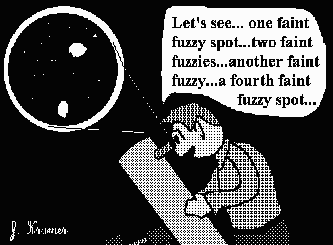Batting 1000
Jack Kramer
Astronomy has been a hobby of mine since about the age of twelve; that means I've been observing off and on for over forty years. Along the way, you can't help but learn a few things about the deep sky. In the beginning, your goal is the Messier objects, which are fairly bright. Along the way, you've probably also spotted the more prominent NGC objects. Eventually, most of what's left are pretty faint or positioned poorly for observation, and after the first few hundred, the going gets tougher. My 1000th object was an unimpressive 12.5 magnitude galaxy in Lynx - NGC 2782.

Reviewing my observation records has been easy because they're maintained in a computer database using dBASE III+. This allows searches and sorts, plus the ability to maintain records in numerical order. It also provides an automatic count of the number of entries; that acts as a constant spur to reach another milestone. If you have a computer and are not now using it to keep your observation records, you owe it to yourself to look into a database. There are many programs suited to this type of record keeping. A couple are available in the club software library. My earliest records were hand- written notes going back to the 1950's. In the mid 1980's, I transferred all records to a trusty old Commodore 64 computer, then eventually to the IBM-compatible world.
New Mexico was the site that accounted for 26% of my observations. An advantage of going on those trips is the ability to dredge up a lot of objects at southerly declinations in an area where the sky is black right down to the horizon. About 24% were observed from our well-frequented site in Hebron. Surprisingly, 19% of the objects were first spotted from my home in Libertyville. That says something about backyard observing, even from our light-polluted suburbs. Of course, a good nebula filter is often essential.
Some objects observed ten or more years ago were recorded simply as "faint fuzzy spots". As I read articles by the more seasoned observers and gained personal experience, it became obvious that most of the faint fuzzies reveal a few subtle details that can only be gleaned with careful, prolonged observation. This prompted re-observation of some objects given short shrift years ago. And observing became more enjoyable if I forced myself to linger over even the faintest objects so as to have something to write about them in the observing record. Even so, there are many objects about which it's difficult to write more than just a few words.
Looking at even very faint galaxies, you might note whether there are any stars visible in close proximity. Perhaps one star doesn't belong there. That's how Robert Evans spots his supernovas. Are the edges of the galaxy distinct or do they fade off gradually? Well-defined edges sometimes betray dust lanes. Is the central hub prominent or is there none visible? Does the surface brightness appear uniform or is it mottled, thus indicating some structure? If the galaxy is a barred spiral, can you detect any indication of the bar? Some large galaxies such as M101, M31, and M33 have HII regions or star clouds in their spiral arms that are prominent enough to sport their own NGC numbers. How many can you find?
Do open clusters contain any unique stars that appear redder than the others? This is one of the problems studied by astronomers - certain clusters appear to contain a few stars that are farther along the main sequence (older) than the rest of the cluster members. Do the stars appear to be of fairly uniform luminosity or is there a wide range of magnitudes represented? Do you see any stars that appear to be doubles? Does a globular have any "star poor" areas, or is there a fairly regular distribution? Are the stars compacted or is it a loose cluster?
Can you detect the central star in a planetary nebula? Is the surface brightness uniform, or is there an annular structure such as in the Ring Nebula? Does the shape of a nebula change depending on the type of filter used? That can signal the presence of different elements in the soft glow that you see. Can you detect any color in the nebulosity? Certain nebulae have a subtle blue or green tinge. Are there stars embedded in diffuse nebulae? How many can you detect? What shape is the nebulosity, or is it so vague as to be almost formless? Not all nebulae emit or reflect light, so look for the dark nebulae too; they're usually designated as Barnard objects. Often they show up as fairly empty spots in an otherwise richly star-populated region.
After an observing milestone, the normal reaction is "Where do I go from here?" It happens all the time to those who complete their Messier lists. After awhile, you find that the quantity of objects seen of itself becomes unimportant. There's a quote from the French novelist Marcel Proust that seems to fit here: "The real voyage of discovery consists not in seeking new landscapes but in having new eyes". One challenge would be to revisit some of the objects where features were missed that other observers have noted. Maybe another night will have better sky conditions. And perhaps a few objects will reveal a bit more of themselves than when I originally recorded them simply as "faint fuzzy spots"!
Published in the March 1994 issue of the NightTimes




